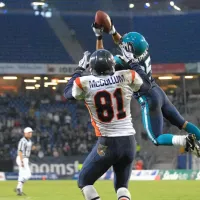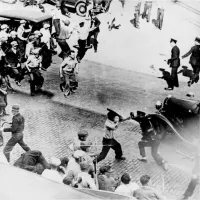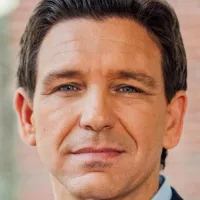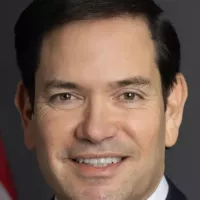Iceland is a Nordic island country situated between the North Atlantic and Arctic Oceans on the Mid-Atlantic Ridge, culturally and politically tied to Europe. Reykjavík is its capital and largest city, housing approximately 36% of the 380,000 residents. Icelandic is the official language. Geologically active due to its location on a tectonic plate boundary, Iceland features geysers, volcanoes, volcanic plateaus, lava fields, mountains, glaciers, and glacial rivers. Despite its proximity to the Arctic Circle, the Gulf Stream moderates Iceland's climate, resulting in temperate conditions, though summers remain chilly. Most of the country experiences a polar climate due to its latitude and marine influence.
1900: Þórarinn Þorláksson Returns to Iceland
Following formal training in art in the 1890s in Copenhagen, Þórarinn Þorláksson returned to Iceland in 1900 to paint and exhibit works, primarily portraying the Icelandic landscape.
1904: Home Rule Expanded
In 1904, Denmark expanded Iceland's home rule, and Hannes Hafstein became the first Minister for Iceland in the Danish cabinet, marking a step towards greater autonomy.
1915: Women gain the right to vote (with restrictions)
In 1915, women in Iceland first gained the right to vote, although the right was initially subject to certain restrictions.
January 1918: Lowest Temperature Recorded in Iceland
On January 22, 1918, the lowest temperature recorded in Iceland was −38 °C (−36.4 °F) at Grímsstaðir and Möðrudalur in the northeastern hinterland.
1918: Danish–Icelandic Act of Union
In 1918, influenced by nationalism, Iceland's struggle for independence culminated in the Danish–Icelandic Act of Union, establishing the Kingdom of Iceland, which shared a monarch with Denmark through a personal union.
1920: Increased voting rights for women
In 1920, women in Iceland saw an increase in their voting rights, further expanding their political participation.
1924: Death of Þórarinn Þorláksson
From 1900 to his death in 1924, Þórarinn Þorláksson painted and exhibited works, almost exclusively portraying the Icelandic landscape.
1929: Formation of Kvæðamannafélagið Iðunn
In 1929, a modern revitalisation of the Icelandic rímur tradition began with the formation of Kvæðamannafélagið Iðunn.
June 1939: Highest Air Temperature Recorded
On June 22, 1939, the highest air temperature recorded in Iceland was 30.5 °C (86.9 °F) at Teigarhorn on the southeastern coast.
April 1940: German Occupation of Denmark
In April 1940, after the German occupation of Denmark, the Althing replaced the King with a regent and declared that the Icelandic government would take control of its own defence and foreign affairs.
1941: United States Invited to Defend Iceland
In 1941, the Government of Iceland, friendly to Britain, invited the then-neutral United States to take over its defence, allowing Britain to use its troops elsewhere.
1942: Regent Appoints Non-Parliamentary Government
In 1942, the regent, Sveinn Björnsson, appointed a non-parliamentary government in Iceland.
December 1943: Expiration of Danish-Icelandic Act of Union
In December 1943, the Danish–Icelandic Act of Union expired after 25 years, setting the stage for Iceland to determine its future relationship with Denmark.
May 1944: Icelandic Plebiscite on Independence
Beginning in May 1944, Icelanders voted in a four-day plebiscite, with 97% voting to end the personal union with Denmark and 95% in favor of a new republican constitution.
June 1944: Iceland Formally Becomes a Republic
On June 17, 1944, Iceland formally became a republic with Sveinn Björnsson as its first president, marking a significant moment in its history.
1944: Iceland Becomes a Republic
In 1944, during the occupation of Denmark in World War II, Iceland voted overwhelmingly to become a republic, ending formal ties to Denmark.
1944: Republic Founded
Since the republic was founded in 1944, the president has typically appointed the cabinet after a general election.
1946: US Defence Force Leaves Iceland
In 1946, the US Defence Force Allied left Iceland after fulfilling its wartime role, marking a shift in the nation's defense arrangements.
1949: Planting of Sitka Spruce
In 1949, a sitka spruce was planted in Kirkjubæjarklaustur. By 2013 it measured at 25.2 m (83 ft) and it is currently the tallest tree in Iceland.
1950: Iceland Joins the Council of Europe
In 1950, Iceland joined the Council of Europe, marking a step towards international cooperation and integration.
1950: Iceland Takes Second Place in Bermuda Bowl
In 1950, Iceland took second place (with Sweden) in the Bermuda Bowl bridge championship in Hamilton, Bermuda.
May 1951: Defense Agreement Signed with the United States
On May 5, 1951, Iceland signed a defense agreement with the United States, leading to the return of American troops as the Iceland Defence Force throughout the Cold War.
1951: Creation of the Iceland Defence Force
In 1951, the Iceland Defence Force (IDF) was created by the United States Armed Forces at the request of NATO after the signing of an agreement to provide for the defence of Iceland.
1952: First Cod War begins
In 1952, the first Cod War began between Iceland and the United Kingdom due to the extension of Iceland's fishing zone from 3 to 4 nautical miles.
1955: Halldór Laxness Receives Nobel Prize
In 1955, Halldór Laxness received the Nobel Prize in Literature, becoming the only Icelander to win a Nobel Prize.
1956: First Cod War Ends
In 1956, the first Cod War ended between Iceland and the United Kingdom due to the extension of Iceland's fishing zone from 3 to 4 nautical miles.
1958: Second Cod War begins
In 1958, the second Cod War began between Iceland and the United Kingdom following a further extension of Iceland's fishing zone to 12 nautical miles.
1961: Second Cod War Ends
In 1961, the second Cod War ended between Iceland and the United Kingdom following a further extension of Iceland's fishing zone to 12 nautical miles.
November 1963: Volcanic Eruptions Create Surtsey
In November 1963, a series of volcanic eruptions began, leading to the formation of Surtsey, one of the youngest islands in the world.
June 1968: Surtsey Eruption Ends
In June 1968, the series of volcanic eruptions that created Surtsey came to an end, leaving behind a new island for scientific study.
1969: Last Ice Incursion on North Coast
In 1969, the last ice incursion occurred on the north coast of Iceland, highlighting the rarity of such events due to the warm North Atlantic Current.
1972: Third Cod War begins
In 1972, the third Cod War began between Iceland and the United Kingdom with Iceland extending its fishing zone to 50 nautical miles.
1973: Third Cod War Ends
In 1973, the third Cod War ended between Iceland and the United Kingdom with Iceland extending its fishing zone to 50 nautical miles.
1974: Completion of Route 1 (Ring Road)
In 1974, Route 1, also known as the Ring Road (Þjóðvegur 1 or Hringvegur), was completed. This main road connects most inhabited areas of Iceland and runs around the island.
1975: Fourth Cod War begins
In 1975, the fourth Cod War began between Iceland and the United Kingdom after Iceland further extended its fishing zone to 200 nautical miles.
1976: Fourth Cod War Ends
In 1976, the fourth Cod War ended between Iceland and the United Kingdom after Iceland further extended its fishing zone to 200 nautical miles.
August 1980: Vigdís Finnbogadóttir Assumes Presidency
On August 1, 1980, Vigdís Finnbogadóttir assumed Iceland's presidency, making her the first elected female head of state in the world.
1980: Vigdís Finnbogadóttir elected president
In 1980, Icelanders elected Vigdís Finnbogadóttir as president, the world's first directly elected female head of state.
1983: Founding of the Women's List
In 1983, the Women's List (Kvennalistinn), Iceland's first political party formed and led entirely by women, was founded to promote women's political, economic, and social interests.
1985: Establishment of Iceland Stock Exchange
In 1985, Iceland's stock market, the Iceland Stock Exchange (ISE), was established.
1986: Reykjavík Summit
In 1986, Iceland hosted a summit in Reykjavík between United States President Ronald Reagan and Soviet Premier Mikhail Gorbachev, a key step towards nuclear disarmament.
1986: Reagan-Gorbachev summit in Reykjavík
In 1986, Iceland hosted the historic Reagan-Gorbachev summit in Reykjavík, which set the stage for the end of the Cold War.
1986: Guðrún S. Gísladóttir Stars in The Sacrifice
In 1986, Icelandic actress Guðrún S. Gísladóttir played a major role in Andrei Tarkovsky's film The Sacrifice.
1989: Strong Beer Ban Lifted
In 1989, the ban on strong beer was lifted in Iceland, leading to the creation of bjórlíki.
1991: Iceland Wins World Bridge Championship
In 1991, Iceland won the world bridge championship (the Bermuda Bowl) in Yokohama, Japan.
1992: Children of Nature Nominated for Academy Award
In 1992, Friðrik Þór Friðriksson's film Children of Nature received a nomination for the Academy Award for Best Foreign Language Film, marking the Icelandic film industry's greatest recognition up to that point.
1994: Iceland Joins the European Economic Area
In 1994, Iceland became part of the European Economic Area, leading to diversification of its economy into finance, biotechnology, and manufacturing.
1994: Legislation Concerning Playschools Passed
In 1994, the current legislation concerning playschools (leikskóli) was passed. Nursery school is non-compulsory education for children younger than six years and is the first step in the education system.
1996: Vigdís Finnbogadóttir retires from office
In 1996, Vigdís Finnbogadóttir retired from her position as president of Iceland.
1996: Upper Secondary School Act
In 1996, the Upper Secondary School Act governs the upper secondary education, or framhaldsskóli, in Iceland.
1997: Whale Watching Becomes Important
Since 1997, whale watching has become an important part of Iceland's economy, contributing to the tourism sector.
1999: Iceland participates in NATO bombing of Yugoslavia
In 1999, Iceland participated in the NATO bombing of Yugoslavia.
2000: Icelandic Descent Population in the USA
According to the 2000 US census, there are more than 40,000 Americans of Icelandic descent.
2000: Björk Stars in Dancer in the Dark and Wins Best Actress Award
In 2000, Björk starred in the film Dancer in the Dark and won the Best Actress Award at the Cannes Film Festival. The movie also led Björk to nominations for Best Original Song at the 73rd Academy Awards, with the song I've Seen It All and for a Golden Globe Award for Best Actress in a Motion Picture - Drama.
2000: Geysir Erupts After Inactivity
In 2000, after a phase of inactivity, Geysir started erupting again after a series of earthquakes, marking a change in its behavior.
2001: Atheist or Agnostic Population
According to a study published in 2001, 23% of Iceland's inhabitants identified as either atheist or agnostic.
2001: Increased International Economic Relations
After 2001, Iceland's newly deregulated banks began to raise great amounts of external debt, further increasing international economic relations.
2002: Rise in Gross National Income
Between 2002 and 2007, Iceland's gross national income increased by 32 percent, contributed to by the rise in external debt.
2002: Die Another Day Set in Iceland
In 2002, the James Bond movie Die Another Day was largely set in Iceland.
2003: Iceland supports invasion of Iraq
In 2003, Iceland supported the invasion of Iraq, deploying a Coast Guard EOD team to Iraq.
2003: Constituencies for parliamentary elections changed
In 2003, constituencies for the parliamentary elections in Iceland were changed to the current six constituencies via an amendment to the constitution.
2003: Privatization of Banking Sector
In 2003-2007, following the privatization of the banking sector under the government of Davíð Oddsson, Iceland moved towards having an economy based on international investment banking and financial services.
2005: Migration from Iceland to Norway
In 2005, 293 people moved from Iceland to Norway.
September 2006: Withdrawal of U.S. Air Force interceptor aircraft
On September 30, 2006, the U.S. Air Force withdrew its four to six interceptor aircraft from the Naval Air Station Keflavik.
September 2006: US Withdraws Forces from Iceland
On September 30, 2006, the US withdrew the last of its forces from Iceland, ending a long-standing military presence.
2006: Canada's Icelandic Descent Population
As of 2006, Canada had over 88,000 people of Icelandic descent, reflecting historical emigration patterns.
2006: Elimination of net wealth tax
In 2006, Iceland eliminated its net wealth tax.
December 2007: Percentage of Foreign-Born Residents
In December 2007, 33,678 people (13.5% of the total population) living in Iceland had been born abroad, including children of Icelandic parents living abroad.
December 2007: Start of the Great Recession
The Great Recession began in December 2007, hitting Iceland hard due to the failure of its banking system.
2007: Rise in Gross National Income
Between 2002 and 2007, Iceland's gross national income increased by 32 percent, contributed to by the rise in external debt.
2007: Privatization of Banking Sector
In 2003-2007, following the privatization of the banking sector under the government of Davíð Oddsson, Iceland moved towards having an economy based on international investment banking and financial services.
May 2008: NATO nations deploy fighters for Icelandic Air Policing mission
Since May 2008, NATO nations have periodically deployed fighters to patrol Icelandic airspace under the Icelandic Air Policing mission.
June 2008: Polar Bear Sightings
In June 2008, two polar bears arrived in Iceland during the same month, traveling from Greenland on icebergs, despite the lack of a native Icelandic population.
July 2008: Reykjavík Temperature Record
On July 30, 2008, the temperature in Reykjavík reached a record high of 26.2 °C (79.2 °F).
October 2008: Icelandic Government Raised Interest Rates
In October 2008, the Icelandic government increased interest rates to 18% as part of acquiring a loan from the International Monetary Fund (IMF). Following the rate hike, the Icelandic króna's trading resumed on the open market, with its valuation dropping to around 250 ISK per euro, significantly lower than its previous exchange rate.
October 2008: Emergency Legislation Passed
In October 2008, the Icelandic parliament passed emergency legislation to minimize the impact of the financial crisis. The Financial Supervisory Authority of Iceland used permission granted by the emergency legislation to take over the domestic operations of the three largest banks: Glitnir, Landsbanki and Kaupthing.
November 2008: Nordic Countries Loan to Iceland
In November 2008, the Nordic countries agreed to provide Iceland with a loan of $2.5 billion to help stabilize its economy during the financial crisis.
2008: Iceland's Crisis-Management Decisions
According to Bloomberg in 2014, the crisis-management decisions made in 2008 lead to the trajectory of 2% unemployment.
2008: Iceland Has Nine Chess Grandmasters
As of 2008, Iceland had nine chess grandmasters, a considerable number given the small size of the population.
2008: Iceland Moves Up in ICT Development Ranking
Between 2008 and 2010, Iceland moved up four places in the United Nations International Telecommunication Union's ranking of information and communications technology development.
2008: Anita Briem Stars in Journey to the Center of the Earth
In 2008, Anita Briem starred in the film Journey to the Center of the Earth, with scenes shot in Iceland.
2008: Iceland's Population Reaches 320,000
In 2008, Iceland's population reached 320,000, marking a rapid increase since the mid-19th century.
2008: Icelandic currency crisis begins and OECD Economic Survey
In the spring of 2008, Iceland experienced a currency crisis, and the OECD Economic Survey of Iceland 2008 highlighted challenges in currency and macroeconomic policy.
2008: Potential Emigration of Polish Immigrants
Many Polish immigrants in Iceland were considering leaving in 2008 due to the Icelandic financial crisis.
January 2009: Offshore Licences Announced
In January 2009, Iceland announced its first round of offshore licences for companies to conduct hydrocarbon exploration and production in the Dreki area.
January 2009: Coalition Government Collapse
In January 2009, the coalition government in Iceland collapsed due to public discontent over the handling of the financial crisis.
February 2009: Removal of Central Bank Governor
In February 2009, Davíð Oddsson was removed from his position as Central Bank governor following protests related to the financial crisis.
April 2009: Launch of new patrol ship
On April 29, 2009, despite the ongoing financial crisis, Iceland launched its first new patrol ship in decades.
July 2009: Iceland applies for EU membership
In July 2009, the Icelandic parliament voted in favor of applying for EU membership, and Iceland officially applied on July 17, 2009.
2009: Doctor to Population Ratio
As of 2009, Iceland had 3.7 doctors per 1,000 people, compared with an average of 3.1 in OECD countries.
2009: Iceland Ranks 12th in Network Readiness Index
In 2009, Iceland was ranked 12th in the World Economic Forum's Network Readiness Index, which measures a country's ability to exploit communications technology competitively.
2009: Jóhanna Sigurðardóttir becomes prime minister
In 2009, Jóhanna Sigurðardóttir became prime minister, making Iceland the first country with an openly gay head of government.
2009: Jóhanna Sigurðardóttir becomes first openly LGBT head of government
In 2009, Jóhanna Sigurðardóttir became the world's first openly LGBT head of government when she assumed office in Iceland.
2009: Increased Emigration to Norway
In 2009, emigration from Iceland to Norway saw a significant increase, with 1,625 people moving compared to 293 in 2005, following the economic collapse.
2009: Migration From Iceland
In 2009, the financial crisis in Iceland resulted in the greatest migration from Iceland since 1887, with a net emigration of 5,000 people.
March 2010: Poll on adopting the Euro
A poll released on March 5, 2010, showed that 31% of respondents in Iceland were in favor of adopting the euro, while 69% were opposed.
April 2010: Special Investigation Commission Findings Published
In April 2010, the Icelandic Parliament's Special Investigation Commission released its findings, highlighting the extent of control fraud during the financial crisis.
June 2010: Icelandic Modern Media Initiative Passed
On June 17, 2010, Iceland's parliament passed the Icelandic Modern Media Initiative, designed to provide strong protections for free speech, journalists, and whistle-blowers.
2010: UNESCO Report on R&D Spending
A 2010 UNESCO report found that Iceland ranked ninth by proportion of GDP spent on R&D among 72 countries.
2010: Iceland Moves Up in ICT Development Ranking
Between 2008 and 2010, Iceland moved up four places in the United Nations International Telecommunication Union's ranking of information and communications technology development.
2010: Number of visitors to Iceland
In 2010, Iceland received a third of the tourists who came in 2016.
2010: Iceland Named Greenest Country
In 2010, Iceland was recognized by Guinness World Records as "the Greenest Country" based on the Environmental Sustainability Index, achieving a score of 93.5/100.
2010: Unemployment rate
In 2010, Iceland's unemployment rate was 8.1%.
2011: Iceland Ranked Highly in Press Freedom
According to a 2011 report by Freedom House, Iceland was ranked as one of the highest countries in press freedom.
2011: Iceland's quality of life ranking
According to the Economist Intelligence Index of 2011, Iceland had the second-highest quality of life in the world.
2011: OECD Assessment of Iceland
An assessment by the OECD in 2011 determined that Iceland had made progress in creating a sustainable fiscal policy and restoring the health of the financial sector, but challenges remained.
2011: Icelandic Sign Language Recognized
In 2011, Icelandic Sign Language was officially recognized as a minority language in Iceland, marking a significant step for the deaf community.
2011: Reykjavík Designated UNESCO City of Literature
In 2011, Reykjavík was designated a UNESCO City of Literature, highlighting its rich literary heritage.
February 2012: Poll on EU membership
A poll conducted in February 2012 found that 67.4% of Icelanders would reject EU membership in a referendum.
June 2012: Unemployment rate
As of June 2012, Iceland's unemployment rate was 4.8% of the labour force.
June 2012: Landsbanki Repays Half of Icesave Debt
By June 2012, Landsbanki had managed to repay approximately half of the Icesave debt, marking a milestone in recovering from the financial crisis.
2012: Gallup Poll on Religious Beliefs
A Gallup poll conducted in 2012 found that 57% of Icelanders considered themselves "religious", 31% considered themselves "non-religious", and 10% defined themselves as "convinced atheists."
2012: Survey on Life Satisfaction
A survey conducted in 2012 found that around three-quarters of respondents stated they were satisfied with their lives.
2012: Anna S. Þorvaldsdóttir Receives Nordic Council Music Prize
In 2012, Anna S. Þorvaldsdóttir received the Nordic Council Music Prize, recognizing her contributions to classical composition.
2012: Iceland ranked in the Index of Economic Freedom
In 2012, Iceland was ranked 27th in the Index of Economic Freedom.
2012: Iceland's Economy Stabilized
In 2012, Iceland's economy stabilised under the government of Jóhanna Sigurðardóttir and grew by 1.6%.
2012: Prometheus Filmed in Iceland
In 2012, some scenes for Ridley Scott's film Prometheus were filmed in Iceland.
February 2013: Iceland Examines Internet Pornography Protection Methods for Children
In February 2013, the Icelandic ministry of the interior researched possible methods to protect children in regards to Internet pornography.
2013: Eurostat Report on R&D Spending
According to a 2013 Eurostat report by the European Commission, Iceland spends around 3.11% of its GDP on scientific research and development (R&D), which is over 1 percentage point higher than the EU average.
2013: Shift in public opinion against EU membership
In 2013, opinion polls indicated that many Icelanders were against joining the EU.
2013: Independence Party Returned to Power
In 2013, the centre-right Independence Party was returned to power in coalition with the Progressive Party.
2013: Sitka Spruce Height Measured
In 2013, the tallest tree in Iceland, a sitka spruce planted in 1949 in Kirkjubæjarklaustur, was measured at 25.2 m (83 ft).
2014: Bloomberg Reports on Iceland's Unemployment Trajectory
In 2014, Bloomberg reported that Iceland was on track to achieve 2% unemployment due to crisis-management decisions made in 2008, including allowing banks to fail.
2014: Interstellar Filmed in Iceland
In 2014, some scenes for Christopher Nolan's film Interstellar were filmed in Iceland.
2015: Iceland's public debt
As of 2015, Iceland's public debt was the 31st-highest in the world by proportion of national GDP.
2015: Anna S. Þorvaldsdóttir Chosen as Kravis Emerging Composer
In 2015, Anna S. Þorvaldsdóttir was selected as the New York Philharmonic's Kravis Emerging Composer, an honour that included a $50,000 cash prize and a commission to write a composition for the orchestra.
2015: Iceland informs EU it will no longer pursue membership
In 2015, Gunnar Bragi Sveinsson, the Minister for Foreign Affairs, informed the EU that Iceland would no longer pursue membership.
2015: Iceland Qualifies for Eurobasket
In 2015, Iceland qualified for Eurobasket.
2015: Iceland's ranking in the Global Competitive Index
In 2015, Iceland ranked one place higher than the 29th it ranked in 2016 in the World Economic Forum's Global Competitive Index.
2015: Television series Trapped aired
In 2015, the television crime series Trapped was produced.
March 2016: Trapped aired in the UK on BBC4
In March 2016, the television crime series Trapped aired in the UK on BBC4, to critical acclaim.
2016: Iceland's ranking in the Global Competitive Index
As of 2016, Iceland ranked 29th in the World Economic Forum's Global Competitive Index.
2016: Number of visitors to Iceland
In 2016, 1.7 million people visited Iceland, which is 3 times more than in 2010.
2016: Iceland Ranks Third in Coffee Consumption
In 2016, Iceland ranked third worldwide in per capita coffee consumption.
2016: Iceland Ranked Among Top Green Economies
In 2016, Iceland was ranked among the top 10 greenest economies in the world by the Global Green Economy Index, due to its commitment to renewable energy.
2016: Ranking of Democratic Institutions
In 2016, Iceland was ranked second in the strength of its democratic institutions.
2016: High CO2 Emissions Per Capita
In 2016, Iceland's CO2 emissions per capita were 16.9 tonnes, the highest among EFTA and EU members, largely due to transport and aluminium smelting.
2016: Prime Minister Resigns After Panama Papers Scandal
In 2016, Prime Minister Sigmundur Davíð Gunnlaugsson resigned after being implicated in the Panama Papers scandal and early elections resulted in a right-wing coalition government.
2016: Archaeologists Uncover Longhouse
In 2016, archaeologists uncovered a longhouse in Stöðvarfjörður that may date to as early as 800, providing insights into early settlement.
October 2017: New Coalition Government Formed
In October 2017, snap elections brought to power a new coalition consisting of the Independence Party, the Progressive Party, and the Left-Green Movement, headed by Katrín Jakobsdóttir.
2017: Iceland Qualifies for Eurobasket
In 2017, Iceland qualified for Eurobasket.
2017: Religious Affiliations
The Registers Iceland keeps account of the religious affiliation of every Icelandic citizen, and they were divided into religious groups in 2017.
2018: Trust in Legal Institutions
As of 2018, Iceland scored second in Europe for their trust in legal institutions (police, parliament and judiciary) at a mean of 73% trust.
2018: Hafþór Júlíus Björnsson Wins World's Strongest Man
In 2018, Hafþór Júlíus Björnsson won the World's Strongest Man competition.
2019: Iceland's Ranking in the Global Innovation Index
In 2019, Iceland was ranked 20th in the Global Innovation Index, which raised to 17th in 2021.
2019: Suicide rate in Iceland
In 2019, the age-adjusted suicide rate in Iceland was 11.2 cases per 100,000.
2020: Fiann Paul Achieves Ocean Explorers Grand Slam
As of 2020, Icelandic explorer Fiann Paul is the first and only person to achieve the Ocean Explorers Grand Slam.
2020: R&D Spending Target
In 2013 Eurostat report by the European Commission, Iceland set a target to reach 4% of GDP on scientific research and development (R&D) by 2020.
2020: Decline of fishing in Iceland's economy
In 2020, Iceland's economic dependence on fishing diminished, with its export share decreasing from 90% in the 1960s to 20%.
March 8, 2021: Recognition of Judaism as a Religion
On March 8, 2021, Iceland formally recognized Judaism as a religion, allowing Jewish citizens to register and direct taxes to their religion, along with civil recognition of Jewish ceremonies.
2021: New Government Formed After Parliamentary Election
After the 2021 parliamentary election, the new government was, just like the previous government, a tri-party coalition of the Independence Party, the Progressive Party, and the Left-Green Movement, headed by Prime Minister Katrín Jakobsdóttir.
2021: Parliamentary Election Results
Following the 2021 parliamentary elections, the biggest parties are the centre-right Independence Party, the Progressive Party and the Left-Green Movement and formed the ruling coalition.
2021: Iceland's Ranking in the Global Innovation Index
In 2021, Iceland was ranked 17th in the Global Innovation Index, up from 20th in 2019.
2021: Iceland's ranking in the UN Human Development Index
In 2021, Iceland was ranked third in the United Nations' Human Development Index report.
2021: Increased female representation in parliament
In the 2021 elections, 48% of members of parliament in Iceland were female, significantly higher than the global average of 16% in 2009.
2022: Iceland Ranked Third in World Happiness Report
In 2022, Iceland ranked third in the World Happiness Report, indicating a high level of well-being among its population.
2022: Iceland's ranking in the UN Human Development Index
In 2022, Iceland was ranked third in the United Nations' Human Development Index report.
2022: Iceland's productivity in 2022
In 2022, Iceland was the eighth-most productive country in the world per capita (US$78,837) and the thirteenth-most productive by GDP at purchasing power parity ($69,833).
2022: Highest antidepressant consumption in Europe
In 2022, Iceland's consumption of antidepressants was the highest in Europe.
2023: Iceland Ranked Third in World Happiness Report
In 2023, Iceland ranked third in the World Happiness Report, indicating a high level of well-being among its population.
2023: Electric Vehicles Constitute Over 50% of New Registrations
In 2023, battery electric vehicles accounted for 50.1% of new vehicle registrations in Iceland.
April 2024: Bjarni Benediktsson Becomes Prime Minister
In April 2024, Bjarni Benediktsson of the Independence party succeeded Katrín Jakobsdóttir as prime minister.
August 2024: Halla Tómasdóttir becomes president
In August 2024, Halla Tómasdóttir assumed office as the president of Iceland.
November 2024: Social Democratic Alliance Biggest Party in Snap Election
In November 2024, centre-left Social Democratic Alliance became the biggest party in a snap election, meaning Social Democratic Kristrun Frostadottir became the next Prime Minister of Iceland.
2024: Iceland Ranked Most Peaceful Country
According to the 2024 Global Peace Index, Iceland is ranked as the most peaceful country in the world.
2024: Iceland's ranking in the Global Innovation Index
According to the Global Innovation Index, Iceland is the 22nd most innovative country in the world in 2024.
2024: Akureyri Airport Opens Expanded International Terminal
In 2024, Akureyri Airport opened an expanded international terminal, enhancing its capacity for international service.
2024: Iceland Ranked Third in World Happiness Report
In 2024, Iceland ranked third in the World Happiness Report, indicating a high level of well-being among its population.
2024: 18% of the country's vehicle fleet was electrified
In 2024, it was recorded that around 18% of the country's vehicle fleet was electrified.
2030: Government Target for Emissions Cut
Iceland's official governmental goal is to cut greenhouse gas emissions by 40% by the year 2030.
2040: Government Target for Carbon Neutrality
Iceland's official governmental goal is to reach carbon neutrality by the year 2040.
Mentioned in this timeline

Basketball is a team sport played on a rectangular court...
The Guardian is a British daily newspaper founded in as...
Germany officially the Federal Republic of Germany is a Western...
Japan is an East Asian island country situated in the...
Iraq officially the Republic of Iraq is a West Asian...

Football is a family of team sports primarily involving kicking...
Trending

Nyjah Huston is a highly accomplished American professional skateboarder recognized as one of the world's highest-paid in his field He...
3 months ago Japan Airlines Enhances Pilot Alcohol Screening & Mileage Bank Offers Cheaper Roundtrips

2 months ago Jessica Pegula at WTA Finals: Match against Paolini, Sabalenka faces Gauff.

1 month ago Riot Releases League of Legends Patch 25.24 with WASD Movement and TFT Set 16.

8 months ago Nebraska family of four dies in apparent murder-suicide on graduation day.

6 months ago Florida's 'Alligator Alcatraz' detention center sparks controversy over migrant treatment and funding.
Popular

Stranger Things created by the Duffer Brothers is a popular...

XXXTentacion born Jahseh Dwayne Ricardo Onfroy was a controversial yet...

Kelsey Grammer is an accomplished American actor producer and singer...

Candace Owens is an American conservative political commentator and author...

Bernie Sanders is a prominent American politician currently serving as...

Marco Rubio is an American politician attorney and diplomat He...